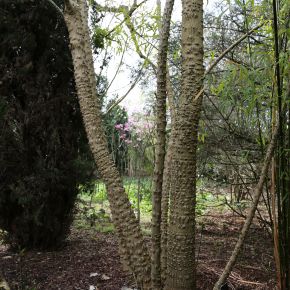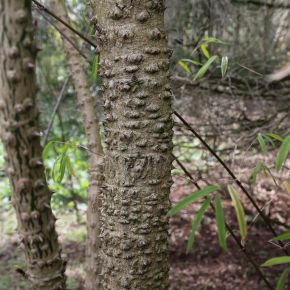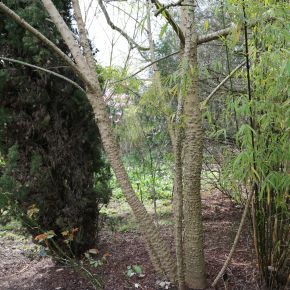Kalopanax septemlobus
(Castor Aralia)
Family - Araliaceae
Category - Tree
Origin - Japan, China, Korea, Russia
Year of Introduction - 1865
Season of Interest - Spring, Summer
Hardiness - H6
Height - 10m or more
Width - 10m or more
Location - The Stream Area, The Thicket
Description: Small to medium-sized Deciduous tree with an upright habit when young, becoming rounded with age. Large, attractive, dark green leaves are palmately lobed and can reach to 30cm or more across on young plants, though will be slightly smaller on older plants. Branched clusters of umbels are composed of tiny, creamy white flowers and are produced in early autumn and then followed by round, nearly black fruit. The flowers are attractive to bees and the fruit is adored by birds. The trunk and young stems are covered in large, foreboding looking prickles, though these become more sparse with age.
In native areas, the leaves of this tree have been used in salads and the bark for medicinal purposes.
Synonyms include -Kalopanax pictus and Acanthopanax ricinifolius
Flower:
Branched clusters of umbels are composed of many, very small, creamy white flowers. Flowers are produced at the tips of the branches in September and will be followed by round, nearly black fruit.
Flower colour: White
Flower shape: Umbels
Flowering time: September
Foliage:
Large, dark green leaves are palmately lobed, each leaf usually with five to seven lobes (septemlobus means with seven lobes). Each leaf has a long petiole and can reach 30cm or more across on young plants, but will be slightly smaller on more mature specimens. The trunk and young branches are covered in large prickles that tend to thin out as the tree matures.
Foliage Senescence: Deciduous
Foliage Shape: Palmately lobed
Propagation:
Seed, cuttings.
Cultivation:
Best in full sun to partial shade in fertile, moisture-retentive, but well-drained soil.



